April Davila's Blog, page 22
May 1, 2020
Steam Beer

 This post is part of an extended series I’m writing about California.
This post is part of an extended series I’m writing about California.You can find out more on my Why California page.
During the 19th century, lager was a popular American beer. By definition, the drink required cold fermentation, but in rugged Northern California where miners were thirsty for brew, refrigeration (and therefore cold fermentation) was a rare luxury.
So innovative brewers struck a compromise. They used a lager yeast, but fermented their beverages at higher temperatures usually reserved for ales. The result was a malty beer, with an aggressive hop bitterness and generous carbonation. They called it a steam beer.
There are several theories as to where the name comes from, the favored version being that due to the high carbonation, the bar keep had to tap it and let off some “steam” before dispensing it.
It was generally considered a blue-collar beer until Anchor Brewing Company refined the drink and trademarked the name in 1981. They claim the term “steam” referred to the steam that emanated from the roof of their brewery in San Francisco. Though the brewery’s history has been a rocky one, complete with earthquakes and prohibition, they have been brewing steam beer since 1896.
April 29, 2020
Settling In
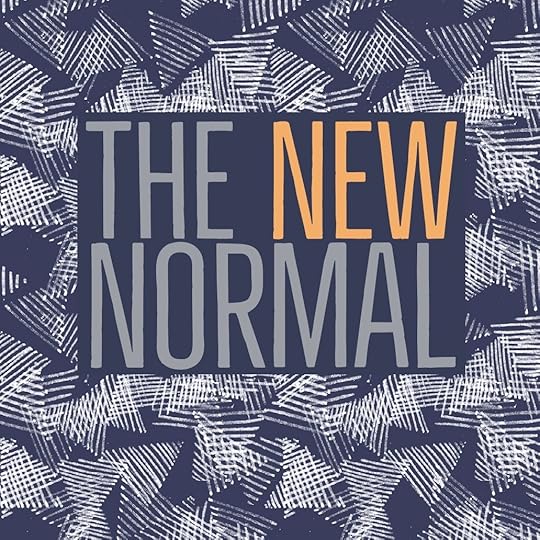
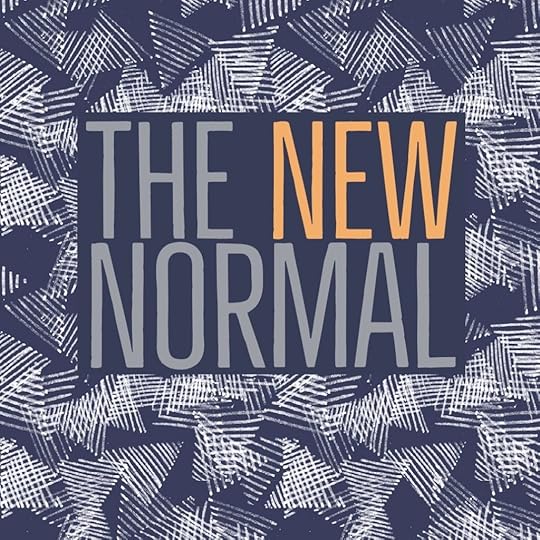
I’ve found it difficult to be creative since all this shelter-in-place business began. There are multiple reasons: I’ve suddenly become a third grade teacher (a job for which I am not qualified). When they’re not in school the kids play and bicker and bring a steady stream of noise. And underlying it all is a low-grade, constant worry, even sadness. I’ve read the articles. I am not alone in this.
This past week we got the official word that the kids will not be going back to school. There’s even talk of not going back in the fall. I will admit, I cried. But once I got over the initial sadness, my thoughts turned to my writing.
If this is going to be our new normal, indefinitely, I need to figure out how it works for me. In short – I need to write. I need to stop waiting for this to all be over, and settle in. Here’s are a few ways I’m getting myself back on track:
Back to 5am
For years I got up at 5am to write before the kids woke up, before I went to work. It sucked, but I knew I wasn’t going to get any writing done after a long day, so it was the only time I could carve out.
Lately I’ve started sleeping in, getting up with the kids. With all routines out the window, I kept telling myself that I could write whenever, but the truth was, it never happened.
I need solitude to be creative. And not just a closed door. As soon as the kids are awake there’s a part of my brain that is tracking them through the house, listening to the screams to determine when I need to step in to stop a fight, thinking about when I should make a snack to ward off the hangries.
Reluctantly, I’ve started getting up at 5am again. It sucks, but it’s also awesome. It’s such focused creative time. And no matter what stupid things I get distracted with for the rest of the day, I’ve done my writing, and that feels good.
Journaling
I’ve been journaling for years, but I’m finding it to be very therapeutic these days. Since the stay-at-home order went into effect I’ve started labeling the days. This morning was Day 48 for us.
Sometimes I’ll document what’s in the news, the death tolls, the word from the White House, that kind of thing. Other times I just talk about what we’re doing here in our home to pass the days, the challenges of home schooling, etc.
Sometimes I work out story ideas, but not often. But I do count it as writing. My pen is on the page, and so I am writing. Even if I don’t work on my novel, I’m writing, and that helps me feel more like me.
Meditation
If you follow along, you know I’m big into meditation. I’ve practiced off and on since my early twenties, but got much more serious about it about five years ago when I was struggling with depression. It changed my life. Last spring I began a two-year program to become a meditation instructor.
So it’s not surprising that in these tough times (ug – that phrase) I’ve doubled down on meditation to find some peace in my own heart. If you’re interested, there are so many good resources online. Even teachers who never taught online before are hosting zoom rooms like champs. Here are a few to check out:
Thursday Morning Meditations – I joined forces with a friend of mine who is also studying to be a mindfulness instructor and we are offering short, half-hour sessions on Thursday mornings. We give a short talk, followed by a short guided meditation, and wrap up with a few minutes of open conversation. New faces are always welcome.InsightLA and Spirit Rock – These two meditation centers (one in Southern California, one in Northern California) have been the at the center of my own journey. They offer so many excellent classes with top-notch instructors, and right now it’s all online. Definitely check them out. The Mindful Bug – This site offers short (15 minute) sessions for people who just want to minimize stress, and longer ones (30 minute classes) specifically geared toward health care workers. She also offers a weekly class for kids. All free. SoundsTrue.com – This a great resource for all things mindfulness related, including classes, books, podcasts and more. Much of their content is being offered at a reduced price, or even for free. Check out offerings by Jack Kornfield and/or Tara Brach. They are the teachers I’m studying with. I adore them for their humor and wisdom.
And Onward
It may be a while before things return to normal. And normal may not be what it was. There are so many unknowns right now. One of the few things I know for sure is that I am better (happier, more steady) when I’m writing.
How are you doing with your writing? Have you been derailed? Or are you settling in? Have you found time to write? Would love to hear from you all. Drop a note below or hit me up on Twitter or Instagram.
April 27, 2020
Outline View in Scrivener

I’m kind of surprised it’s taken me this long to get to a discussion of Scrivener’s Outline View. Here we are in week 39 of the #52WeeksOfScrivener series. I guess it’s long overdue.
Get There
To open Outline View, simply click on the little icon at the top of the screen that has four horizontal blue lines.

You’ll get an outline of your project that looks like this:

But it’s not terribly useful unless you can add some information. First: the scene synopsis. You can either write a synopsis for each scene by clicking in the Synopsis section of the Inspector. OR, Scrivener can fill in a synopsis for you, using the beginning of each chapter. Simply select the chapters you want to fill in (command click on mac), click on Documents -> Auto-Fill -> Set Synopsis from Main Text.

Here’s what the same outline looks like with the synopsis auto-filled from the main text:

Decide What Displays
Once you have yourself an outline, you’ll want to decide what you’re going to see in this mode. To do this, click the greater than symbol (>) at the top of the screen and then click or unclick the tick boxes that appear in the drop down.
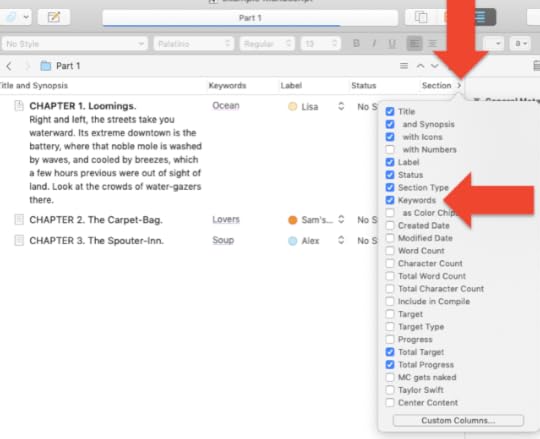
Options that we’ve covered in the #52WeeksOf Scrivener include:
Synopsis (explained above)KeywordsLabelsWord Counts, Targets, and Progress Bars
It’s worth noting that you can drag the headers right and left to organize the items in your outline.
For that matter, you can drag and drop chapters to move them up or down. This can come in really handy if you’re just getting started with a story and you’re playing around with the structure.
Next Week
Next week we’ll talk about the 6 other layouts that Scrivener has to offer. I bet you didn’t know there were 6. Stay tuned. You can follow along on Twitter with #52WeeksOfScrivener, or sign up for my newsletter to get a weekly digest of all my posts.
April 24, 2020
The Rainbow Flag

 This post is part of an extended series I’m writing about California.
This post is part of an extended series I’m writing about California.You can find out more on my Why California page.
Sometimes called the pride flag or gay pride flag, the rainbow flag has been a symbol of gay rights in San Francisco since it was first used as such by artist and activist Gilbert Baker in 1978.
Originally Baker used eight colors for the rainbow flag to symbolize diversity in the LGBT community; pink, red, orange, yellow, green, blue, indigo, and violet. But when it came time to mass-produce the banner, hot pink dye was not yet available commercially, so the flag was reduced to seven stripes.
Local legend says the indigo stripe was removed so that demonstrators could carry three stripes down each side of the street during a parade commemorating the city’s first openly gay supervisor Harvey Milk after his assassination in November 1978.
The resulting six-stripe rainbow flag is now recognized by the International Congress of Flag Makers. Every June, San Francisco celebrates pride month, hosting the largest pride celebration and parade in the nation. Though the flag is present year round, during June the colors fly from every lamppost and window from Embarcadero to 19th Avenue.
April 22, 2020
The Evolution of a Novel


Last weekend, I was cleaning out a bookshelf of mine where I’ve stashed all of my journals over the years. Between my morning scribblings, my ideas for stories, and my BuJo day planners (why did I even keep those?), I had a pretty fat collection. And in with it all, I found the story idea journal I kept way back when I was starting out with the novel that would become “142 Ostriches.”
Evolving Ideas
I went through so many versions of this story. I mean, really. At one point in the evolution of the story Tallulah was a bank robber. Then it became a road trip story, no joke – she loses the farm, steals three birds, and heads across country with them to find a new home. Matt was once a mute monk. Grandma Helen started out as Grandpa Hank. (If you haven’t yet read the book, I’m giving nothing away – these ideas faded out of existence years ago. Also, here’s the link to buy the book.)
I was just so bound and determined to write something that I jumped in with both feet and went for it. Draft after draft I worked through all these wrong ideas. For a while Tallulah was African American. For a few drafts it ended with a desert rave. What? Yes. A rave.
But in all that time, I also discovered a lot about my story that was useful. I drew scale maps of the ranch. I sat in little road-side diners in the Mojave and wrote observations of the locals. I did deep dive character studies, listing out Tallulah’s favorite ice cream, her best subjects in school, her worst nightmare, her shoe size.
What Now?
So now the question becomes: do I keep all this? And if so, why? As I cleaned out the shelf of old journals I tossed all the day planners and labeled all the journals with my (almost) daily morning pages. Here’s what it looks like (and yes, I have too much time on my hands – shut up):
 (so satisfying)
(so satisfying)But what do I do with this notebook full of old ideas for the book I’m finally done with? I kind of want to keep it, but that’s just me being sentimental. There’s no reason.
On the contrary, there’s a very good reason to let it go. It’s just taking up space. And what’s more, I feel kinda icky when I look at it. It feels like a reminder of a very hard lesson learned: outlining this story, at the outset, would have saved me years.
So I’m taking Kondo’s advice and letting it go. Right now. Dropping it in the recycle. Done.
Going Digital
In the future, I won’t even have to make this decision, because in the years since I started writing, I’ve switched to Scrivener. Nowadays I store everything in my research folder in one simple computer file.
And when I’m done with Book Two (titles are hard, so this project doesn’t have one yet), I’ll just close the file and all the scraps of paper and snapshots and urls won’t take up more than a few MB of computer space. And I’ll never have to look at it if I don’t want to.
The best news? I’ll know I didn’t waste seven years writing the wrong story, because I outlined this story thoroughly before I ever wrote a scene. I’m already working on the third draft, which I’m hoping will be the last before I send it to my agent to get his thoughts.
So I guess, all things considered, all those years and all those missteps were really part of learning to be a writer. I’ve built up some momentum, and skill, and I’m super excited about this new project. Stay tuned…
April 20, 2020
Scrivener Footnotes

We talked briefly about Scrivener footnotes as part of a more general post describing the Inspector window, way back in September. But there are a few more things to know about them. The latest version of Scrivener gives you a lot of options that you didn’t have back in the 2.0 edition. So let’s continue the #52WeeksOfScrivener series with an exploration of how footnotes work.
Footnotes
I think people often think of non-fiction when they think of footnotes, but there are some really amazing works of fiction that use them too (Infinite Jest, The Brief and Wondrous Life of Oscar Wao, A Tale For The Time Being).
There are 3 ways to insert a footnote in your writing in Scrivener. To do any of them, you start by placing your cursor where you want the footnote to appear. Then you either:
1.Click on the little cf symbol in your Inspector window:
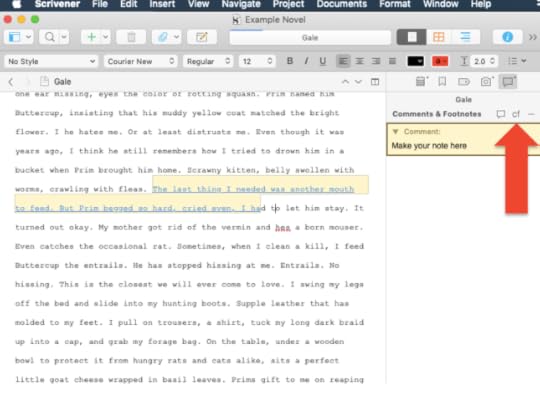
2. Go to Insert -> Footnote

3. Use the keyboard short cuts. If you’re using a lot of footnotes, I highly recommend you get familiar with these. See in the image above where the word Footnote is highlighted in blue? Now see the jargony symbols to the right of the word? That’s your keyboard shortcut. In this instance, it’s Shift Command 8. Hit all three of those on your keyboard at the same time to start your footnote.
Here’s what they look like. You’ll notice that footnotes appear in grey, while comments appear in yellow. They are also labeled “Footnote” in the top of the box there.

Inline Footnotes
The astute observer will notice that, right below the menu item for Insert Footnote is an option for Inline Footnote (Shift Command F). Here’s what those same footnotes look like if I set them to display inline:

You’ll notice they’re still grey, but they appear in the line of the text. To toggle back and forth from inline footnotes to inspector window footnotes go to Edit -> Transformations -> Convert Inline Footnotes to Inspector Footnotes (or to go the other way, choose Convert Inspector Footnotes to Inline Footnotes).

You’ll notice in the two images above that the footnotes no longer appear in the Inspector window. They are now inline.
Things to Note
A few final thoughts on footnotes in Scrivener:
No matter where you’re footnotes display in your WIP, they will always print at the bottom of the page. You can change the color of the comments with control click, but footnotes stay grey.You can change a footnote to a comment with a control click.You can change a comment to a footnote in the same way.If your footnotes are inline and you want to add a new one, you have to use the drop down menu or your keyboard shortcut. Clicking the cf icon (see the very first image in this post) will add an Inspector footnote. Not sure why, but if you have some footnotes inline and some in the Inspector, you can get them all in the same format by going to Edit -> Transformations (as shown above).
And that’s everything I have to say about footnotes in Scrivener.
Next Week
Next Monday we’re going to talk 2 things you should NEVER do in Scrivener. You don’t want to miss this one. Stay tuned, follow on Twitter with #52WeeksOfScrivener, or sign up for my newsletter to get a weekly digest of all my posts.
April 17, 2020
The Artichoke – An Intimidating, Edible Flower

 This post is part of an extended series I’m writing about California.
This post is part of an extended series I’m writing about California.You can find out more on my Why California page.
Native to the Mediterranean region of Europe, the artichoke was introduced to California by Spaniards in the nineteenth century. The plants thrive in the coastal areas above Monterey and eighty percent of the artichokes bought in the United States come from the small town of Castroville.
A relative of the sunflower, the artichoke would bloom into a large flower if left in the field. They grow year round, but are most plentiful from late winter to early spring.
Fun Fact: In 1949 Marilyn Monroe was Artichoke Queen at the Castroville Artichoke festival.
The artichoke can be a little intimidating as foods go, with a sharp thorn at the end of each petal, and many a tourist has avoided the plant because they were unsure how to eat it. Standard etiquette says you use your fingers to pull the leaves free from the plant one at a time, usually dipping the meaty end in a mayonnaise-based sauce, biting off just the tip and discarding most of the leaf. At the center is the heart. Be sure to scrape away all the fuzz, then finish it off.
April 15, 2020
4 Ideas For A Pandemic Book Launch
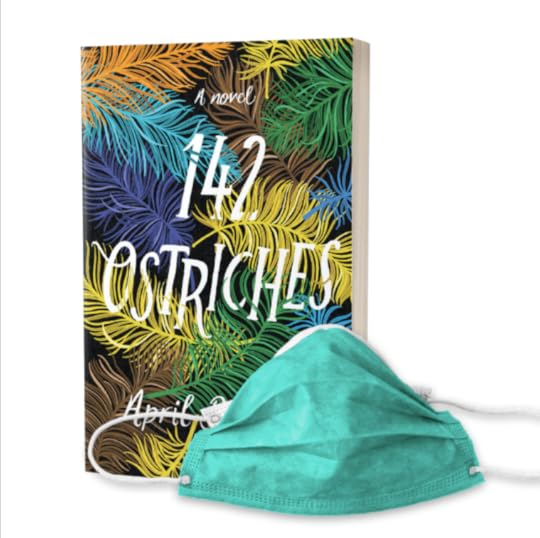

Turns out I’m not alone in trying to navigate a book launch during this pandemic. Not by a long shot. Duh. And since a few of you have reached out asking for tips, I though I’d compiled what I’ve learned so far.
Please keep in mind this list is just what I’ve been looking into for myself and is probably nowhere near complete. If you have ideas I haven’t considered, I hope you’ll share them in the comments below.
Okay, here goes:
1. Personal Emails
Your number one resource is your existing network. You have friends. They have friends. The promotional effort I have found most effective is to reach out, personally, one at a time, to family and friends and simply ask them to buy my book. This is a lot of work. But hey, what else you gunna do?
The details:
make it personal (seriously – 1 person at a time)keep it upbeat (aka don’t whine)be specific (you have to ask them to buy your book)include a link to blurbs or good reviews if you have theminclude a link to where they can buy your bookask them to help you spread the wordif you can afford to, consider offering to buy them a copy (especially if you know they’re strapped for cash)
This last one leads me to:
2. Giveaways
If you follow the blog, you know I’m currently running a promotion of my book wherein anyone who buys (or has bought my book) can get a copy sent to a friend for free. More details here.
This is not without its cost, but I decided it was worthwhile for two reasons. First, it’s an investment in my sales numbers which is an investment in my future book deals. Second, it is getting the book out into the hands of readers. Which is, ultimately, the main goal here.
You can also host giveaways through Goodreads. The nice thing about that platform is that when someone enters the giveaway for your book the title is automatically added to their “Want To Read” list, which will remind them, even if they don’t win, to pick up your book.
3. Podcast Interviews
There are so many awesome literary podcasts out there. Seriously, just google “literary podcast” or maybe something more specific like “romance podcast” or “mystery novel podcast.” They’re out there. And listenership is up, from what I hear.
But how to get on their radar? How to get invited?
Again, I say, make it personal:
Do your homework and listen to at least a few episodes.Write a personalized email about why you’re a good fit for their show. Address that email to the actual host, by name.Offer to send them an ARC or galley.Include a link to good reviews or blurbs.Follow up (with the understanding that they’re probably inundated right now, respectfully keep following up until they say either yes or no)
To get on the Otherppl podcast I wrote Brad an email listing all the reasons I thought we’d have a good conversation. I’ve been a fan for a long time, so I had a pretty extensive list.
4. Partner With A Local Business
I’ve only just started looking into this one, but my thinking is this: there are businesses out there that have a standing client base stuck at home. Maybe they’d like some reading material with their delivery of wine/tacos/toilet paper.
Again, still thinking this one through, but if you can tie your book to say, Mexican food, you could reach out to your local Mexican restaurant and ask them if they would be interested in running a promotional deal wherein customers who order $40 or more get a copy of your book for $4.
Or something. Still working out the details, but I did pitch the idea to a local wine shop here. I’ll let you know how it develops.
Stay Strong
This is not sales advice. This is just me saying – stay strong. This will pass. We will get back out into the world and do readings and festivals and all of those fun authorial things.
In the meantime, try a few of these ideas and share with the rest of us if you’ve had any others. We’re all in this together.
April 13, 2020
Scrivener Dictionary & Thesaurus

I realized last week that I have yet to write a #52WeeksOfScrivener post about the super-handy built in Scrivener Dictionary & Thesaurus.
Check it out. If you want to check the meaning of a word, or find a better one, just control-click the word in question, (or right click for you PC-lovers) to get a drop-down menu. Go to Writing Tools -> Look Up in Dictionary and Thesaurus.
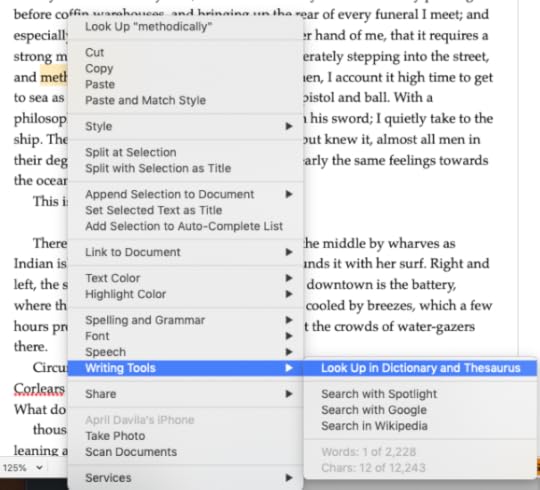
The program will automatically launch an app window that looks like this:

Could you click over to your web browser and do this same thing at Dictionary.com? Yes you could. But seriously, how easy is this? Just one click and it automatically opens to the word you want to know more about.
You also get the added benefit of not jumping to a web browser. I feel like opening Chrome when I’m writing is kind of like admitting that I’m not going to get any more writing done, because oh, look at that, an email, and oh, some click bait (yes, even on Dictionary.com). You know how it goes.
So that’s the Scrivener Dictionary & Thesaurus. I hope you find it as useful as I do.
Next Week
Next Monday we’re going to talk more about Footnotes. Stay tuned, follow on Twitter with #52WeeksOfScrivener, or sign up for my newsletter to get a weekly digest of all my posts.
April 10, 2020
The California Poppy

 This post is part of an extended series I’m writing about California.
This post is part of an extended series I’m writing about California.You can find out more on my Why California page.
When Russian ships cruised the northern California coastline in the early 1800’s they noted that the hillsides appeared lit with golden-orange light. Long before the region became know for the gold rush of the 1850’s, the California Poppy, as it is now known, painted the countryside in bright hues.
Eschscholzia californica is the state’s official flower, chosen in 1890 for the bright orange petals that seemed a fitting symbol of the Golden State. The hardy plant is found mainly in the grassy areas of lower altitudes throughout the region.
Historically the mature plant was harvested by native populations for use as a sedative, analgesic and antispasmodic. Though still used by herbalists today to treat insomnia and anxiety, the plant produces a much milder effect than its controversial cousin the red poppy, which is a main source of opium in many parts of the world.
School children often whisper warnings to each other that to pick the state flower will result in imminent jail time, but in fact, the flower is no more protected than any other plant growing on public lands.
April 6th is California Poppy Day.



